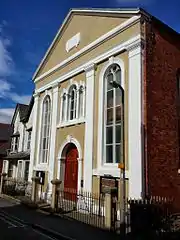Thomas Thomas | |
|---|---|
 Portrait photograph by John Thomas (c. 1875) | |
| Born | 1817 |
| Died | 16 March 1888 (aged 70–71) |
| Nationality | Welsh |
| Other names |
|
| Occupation(s) | Church minister and chapel architect |

Thomas Thomas (1817 – 16 March 1888) was a Welsh church minister and chapel architect, also known as Thomas Glandŵr (Thomas Landore). He is described as "the first national architect of Wales"[1] and the "unchallenged master of chapel architecture in Wales in the 1860s".[2]
Early life
Thomas Thomas was born in 1817 and brought up near Ffairfach, at Llandeilo, Carmarthenshire. His father ran a carpentry business, where Thomas worked before moving to Swansea.[3]
Religious ministry
Though he had no formal training he was appointed as a chapel minister in Clydach in 1848, a post which he held until 1853.[3] Reverend Thomas subsequently became a Congregational minister at Landore, Swansea, until he resigned in 1875. It has been conjectured that he resigned after it was discovered he was the owner of sub-standard workers housing in north Swansea.[2]
Architecture
Thomas was also known an architect and began designing chapels in 1848 and continued through the chapel-building boom of the 1860s and '70s, designing not only for his own Congregational denomination but for others too.[4] He had redesigned Landore's own Siloh Chapel in 1860. The New Siloh Chapel (1878) in Landore was, however, designed after Thomas's resignation by Thomas Freeman who had been a builder and surveyor of the Reverend Thomas's earlier chapels.[2]
Thomas Thomas is credited with at least 119 chapels across Wales. He also made sure he garnered the distinction of preaching the first sermon (or one of the first sermons) at each of his new chapels.[4] His trademark design feature of chapels was the giant arch in the pediment on the facade of his buildings. He also invented the stylistic interior feature of dipping the chapel gallery behind the preacher's pulpit.[4]
Later life
After resigning as a church minister, Thomas moved to Mumbles. He died there on 16 March 1888 and was buried at Sketty.[2]
Notable works

- Capel Bethel, Llansamlet, Swansea, Glamorgan (1849–51 and 1879/80) [5]
- Capel Als, Llanelli, Carmarthenshire (1852/3) [6]
- Saron Welsh Independent Chapel, Tredegar, Monmouthshire (1858) [7][8]
- Capel Tabernacl, Ffairfach, Carmarthenshire (1860) [9]
- Salem Welsh Independent Chapel, Porthmadog, Caernarfonshire (1860) [3][10]
- Sardis Independent Chapel and Schoolroom, Ystradgynlais, Brecknockshire (1860/1) [11]
- Carmel Welsh Independent Chapel, Porth Amlwch, Anglesey (1861/2) [3]
- Capel Mair, St Clears, Carmarthenshire (1862) [12]
- Ebenezer Welsh Independent Chapel, Swansea, Glamorgan (1862) [7]
- Hermon Chapel and Sunday School, Oswestry, Shropshire, England (1862), now Grade II* listed.[13]
- Brecon Congregational Memorial College, Brecknockshire (1869), a college until 1959 later converted into flats.[14]
- Seion Independent Chapel, Llandysul, Cardiganshire (1870/1) [15]
- Hope Independent Chapel, Pontardulais, Swansea (1872) [16]
- Jerusalem Independent Chapel, Resolven, Glamorgan (1876) [17]
- Tabor United Reformed Church, Maesycwmmer, Monmouthshire (1876), now Grade II* listed.[18]
- Mount Pleasant Baptist Chapel, Pembroke, Pembrokeshire (1878) [19]
- Capel Salem, Llangennech, Carmarthenshire (1879) [20]
- Providence Independent Chapel and house, Llangadog, Carmarthenshire (1883/4) [21]
- Bethania Welsh Independent Chapel, Bethesda, Caernarfonshire [3]
- Bethesda Chapel, Llanwrtyd Wells, Powys (enlarged/rebuilt in 1907 by Beddoe Rees, also known as Bethel Chapel)[22]
References
- ↑ "Thomas Thomas (1817–1888)". Stained Glass in Wales (University of Wales Centre for Advanced Welsh & Celtic Studies). Retrieved 6 February 2016.
- 1 2 3 4 Hughes 2000, p. 281.
- 1 2 3 4 5 "Thomas Thomas: First National Architect of Wales". The Story of Nonconformity in Wales (Welsh Religious Buildings Trust). Retrieved 6 February 2016.
- 1 2 3 Hughes 2000, p. pages 271–6.
- ↑ "Capel Bethel including forecourt walls, gates and railings, Llansamlet". British Listed Buildings. Retrieved 7 February 2016.
- ↑ "Capel Als,including Railings,piers & Gates to Chapel Enclosure,marble Hall Road, Llanelli". British Listed Buildings. Retrieved 7 February 2016.
- 1 2 Hughes 2000, p. 275.
- ↑ "Saron Congregational Chapel, including attached schoolroom, Tredegar". British Listed Buildings. Retrieved 7 February 2016.
- ↑ "Capel Tabernacl, Cyngor Bro Dyffryn Cennen". British Listed Buildings. Retrieved 7 February 2016.
- ↑ "Capel Salem, including attached Sunday School, forecourt gates and railings and hall to rear, Porthmadog". British Listed Buildings. Retrieved 7 February 2016.
- ↑ "Sardis Independent Chapel and attached schoolroom, Ystradgynlais". British Listed Buildings. Retrieved 7 February 2016.
- ↑ "Capel Mair, including forecourt railings, St Clears". British Listed Buildings. Retrieved 7 February 2016.
- ↑ "Hermon Chapel, Oswestry". British Listed Buildings. Retrieved 7 February 2016.
- ↑ "Camden Court, Brecon". British Listed Buildings. Retrieved 7 February 2016.
- ↑ "Seion Independent Chapel, Seion Hill, Llandysul". British Listed Buildings. Retrieved 7 February 2016.
- ↑ "Hope Independent Chapel, Pontardulais". British Listed Buildings. Retrieved 7 February 2016.
- ↑ "Jerusalem Independent Chapel, Resolven". British Listed Buildings. Retrieved 7 February 2016.
- ↑ "Tabor United Reformed Church, Maesycwmmer". British Listed Buildings. Retrieved 7 February 2016.
- ↑ "Mount Pleasant Baptist Chapel, Pembroke". British Listed Buildings. Retrieved 7 February 2016.
- ↑ "Capel Salem, Llangennech". British Listed Buildings. Retrieved 7 February 2016.
- ↑ "Providence Independent Chapel, vestry, house and railed forecourt., Llangadog". British Listed Buildings. Retrieved 7 February 2016.
- ↑ "Bethesda Chapel, Welsh Calvinistic Methodist;bethel, Irfon Crescent, Llanwrtyd Wells (6131)". Coflein. RCAHMW. Retrieved 30 September 2021.
Sources
- Hughes, Stephen (2000), Copperopolis: Landscapes of the Early Industrial Period in Swansea, Royal Commission on the Ancient and Historical Monuments of Wales, ISBN 978-1871184327
Further reading
- Hughes, Stephen. "Thomas Thomas - First National Architect of Wales". The story of Nonconformity in Wales. Addoldai Cymru (Welsh Religious Buildings Trust).
